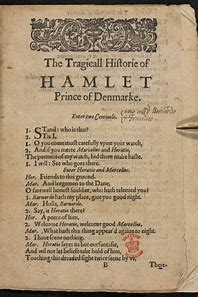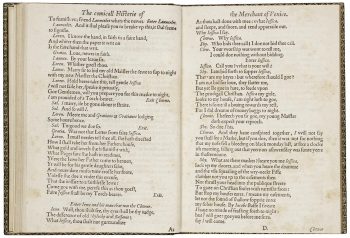A famous 20th century poet loved writing in iambic meter, as shown in these well-known lines:
I do not like them Sam I am,
I do not like green eggs and ham.
What is an Iamb?
Please reread the famous lines above by Dr. Seuss – but this time out loud. If you do, you will likely find yourself employing a sing-songy rhythm:
buh-BUM, buh-BUM, buh-BUM, buh-BUM.
This rhythm, in which unstressed syllables or beats are followed by stressed syllables, is called iambic. Each pair of such syllables, in which an unstressed beat is followed by a stressed one, is called an iamb.
One iamb = buh-BUM.
Why does English poetry use iambic meter?
English poets realized centuries ago that the iambic meter or rhythm is the natural rhythm of the English language. This is because English, with it foundational vocabulary of short, clipped (mostly one-syllable) words fits the iambic rhythm beautifully.
Take another look at Dr. Seuss’ lines from Green Eggs and Ham above – all one-syllable Anglo-Saxon words. Page through any of Dr. Seuss’ children books. Notice the almost exclusive use of short, easy words – this is the vocabulary around which the English language is structured. And its stress-pattern fits that of iambic meter beautifully.
But would you want to watch an entire 2-hour play of Dr. Seuss’ poetry? Methinks not. It would drive you crazy, the endless sing-songy-ness. Why does Dr. Seuss have this effect?
The reason has to do with the fact that there are 4 iambs in each line. Why? Think about how most Western music (other than waltzes) has 4 beats to the measure. This allows you to move your feet and swing your hips in an inherently satisfying and smooth way. But in poetry, such rhythm lacks gravitas. It sounds trivial, like a nursery rhyme.
The use of four iambic feet, known as iambic tetrameter, was never common in serious English poetry.
The Adaptation of Pentameter
Prior to the Elizabethan era, English poets used a variety of meters. They could write lines of five iambs (pentameter), as the Latin, French and Italian poets commonly did, or lines of six iambs (hexameter), as the ancient Greeks usually did. Geoffrey Chaucer, author of the Canterbury Tales, wrote largely in iambic pentameter.
Pre-Elizabethan drama also appeared in a variety of styles. John Heywood wrote in rhyming couplets, but without any meter at all!
It did not take long for Elizabethan playwrights to adopt iambic pentameter as the go-to meter for English language plays. No doubt this unofficial decision was helped along immensely by the spectacular success of the plays of Christopher Marlowe, which were written in fairly strict iambic pentameter – that is, without a lot of variation built into it.
 Indeed, iambic pentameter is the perfect meter for English language drama: verse written in iambic pentameter is stream-lined, avoiding the bulkiness or clunkiness of lines of six iambs or more; and it avoids the frivolousness of lines that are too short: iambic pentameter is poetry for adult sensibilities, with gravity and majesty.
Indeed, iambic pentameter is the perfect meter for English language drama: verse written in iambic pentameter is stream-lined, avoiding the bulkiness or clunkiness of lines of six iambs or more; and it avoids the frivolousness of lines that are too short: iambic pentameter is poetry for adult sensibilities, with gravity and majesty.
The Greek root for “5” is of course penta. Since each iamb appears 5 times in each line, we call this style of English verse iambic pentameter.
We may also note here that English playwrights, starting in the Elizabethan era, wrote their drama without regular rhyming, in a style known as blank verse.
Take a look at the following famous lines from Shakespeare: notice how each line has 5 iambs, for a total of 10 syllables. Notice also how every word, with the possible exception of question, is an ancient English word, descending from old English:
Buh-BUM buh-BUM buh-BUM buh-BUM buh-BUM
- a HORSE, a HORSE, my KING-dom FOR a HORSE.
- The lady doth protest too much, methinks.
- But soft, what light through yonder window breaks?
Once established, iambic pentameter became the dominating, indeed universal, meter of the Elizabethan period (and beyond as well).
A Quick Review of other Meters
In iambic pentameter, each line of verse has 10 syllables, starting with an unstressed beat (syllable), followed by a stressed beat, and back again, strictly alternating, until a total of 10 syllables are reached:
Buh-BUM buh-BUM buh-BUM buh-BUM buh-BUM
If MU-sic BE the FOOD of LOVE, play ON.
Each buh-BUM is called a foot (a foot being defined as the rhythmic grouping of syllables that is repeated). Since each foot (buh-BUM) appears 5 times in each line, we have penta-meter. The specific foot with the buh-BUM pattern of stresses is called an iamb. Hence, iambic pentameter.
Only rarely will authors slip into other meters. Love songs or brief ditties, for example, might appear in trimeter or tetrameter (3 or 4 feet); these shorter meters create the feeling of a nursery rhyme, so are less elegant and dramatic. Incantations or ceremonial speeches might also contain fewer feet than five, giving a ritualistic feeling to the lines. Ancient Greek plays and epics, on the other hand, were written in (what in English would be cumbersome) heptameter (7 feet).
If the stresses of a 2-syllable foot are reversed (BUH-bum), then you have what is known as a trochee: “driveway” and “callous” are examples of this pattern.
Three-syllable feet that may appear include dactyl (BUH-bum-bum, as in “Budapest”); amphribach (buh-BUM-buh, as in “cathartic”); and anapest (buh-buh-BUM, as in “Tennessee”). Limericks are written with 3-syllable feet:
There ONCE was a MAN from nan-TUCK-et
Early Elizabethan Drama: Strict Iambic Pentameter
Early Elizabethan drama tended toward what we will call strict iambic pentameter (“strict IP”). Strict IP is unvarying, always exactly 10 syllables in a line, and sentences always ending after the last syllable in a line. Consider these lines from Christopher Marlowe’s Tamburlaine the Great:
Sit up, and rest thee like a lovely queen.
So now she sits in pomp and majesty,
When these, my sons, more precious in mine eyes
Than all the wealthy kingdoms I subdued,
Placed by her side, look on their mother’s face.
Now read them again, but out loud. Emphasize the buh-BUM buh-BUM buh-BUM, alternating stresses.
Strict IP is mesmerizing, hypnotic; one line blazes into the next, accelerating dramatically, without interruption. It is pounding and captivating.
But after three hours, it is boring. Any verbal pattern that remains unvaried will, over time, become tiring.
Variations in Iambic Pentameter
Early on, dramatic authors, sensing the limitations of strict IP, and perhaps desiring more flexibility in their writing, began to introduce variations, breaking down strict IP’s rigid restrictions.
The result was dialogue that became more realistic, mimicking with greater accuracy the way people really spoke, with its irregular pauses, and clipped, quickly-exchanged utterances. When recited on-stage, the IP in the spoken lines became less noticeable, perhaps invisible; but on paper, the underlying structure remains, and by mouthing the words as we read the lines, the variety of modifications to the IP clearly stand out. This greatly enhances our appreciation and enjoyment of the verse.
It is critical to remember that even if the IP is not noticeable to listeners at the conscious level, the underlying pattern of the IP is still there, giving the dialogue a sense of fullness and artistry that would be lacking without it; to readers of these works, however, the patterns remain more visible.
So let us review the ways our dramatists veered away from strict IP.
A. Ending Sentences in the Middle of Lines
Earlier IP tended to have sentences end exactly at the end of lines. Here is an example from an early Shakespeare play, Titus Andronicus:
Noble patricians, patrons of my right,
Defend the justice of my cause with arms;
And, countrymen, my loving followers,
Plead my successive title with your swords:
I am his first-born son, that was the last
That wore th’ imperial diadem of Rome;
Then let my father’s honours live in me,
Nor wrong mine age with this indignity.
 Now compare these lines from Shakespeare’s last play, The Tempest:
Now compare these lines from Shakespeare’s last play, The Tempest:
To have no screen between this part he played
And him he played it for, he needs will be
Absolute Milan. Me, poor man, my library
Was dukedom large enough: of temporal royalties
He thinks me now incapable; confederates…
When the sentences can end anywhere, the effect is more natural speech.
B. Altering the Number of Syllables in Some Lines
1. Adding an extra syllable to the end of a line.
Another major change was to allow an extra, 11th unstressed syllable to the end of some lines – the so-called “feminine ending”.
Read these lines, spoken by Juliet, aloud; note the mix of 10- and 11- syllable lines:
Shall I speak ill of him that is my husband?
Ah, poor my lord, what tongue shall smooth thy name,
When I, thy three-hours wife, have mangled it?
But, wherefore, villain, didst thou kill my cousin?
That villain cousin would have killed my husband:
Back, foolish tears, back to your native spring;
Note how the feminine endings of the first, fourth and fifth lines force you to pause awkwardly before you begin the next line with another unstressed syllable.
2. Alexandrines: the 12-syllable line.
Adding an extra syllable to the end of a line.On rare occasion, an author may feel the need to include a line of 12 syllables, so that you end up with six iambs. These are called alexandrines. Shakespeare’s Richard II is well-known for containing quite a large number of such alexandrines:
- As now as I can sift him from that argument
- Rouse up thy youthful blood, be valiant, and live.
- That which his noble ancestors achieved with blows.
3. Adding an extra syllable to the beginning of a line.
In this variation, the line may end up with 10, 11 or 12 syllables; consider the following lines:
- By his mother, sister, and his fairest duchess… (Philip Massinger’s The Duke of Milan)
- I am sure against my will; and if you find… (The Duke of Milan)
- Many years of happy days befall… (Richard II)
- Speak, my modern man; I say, provoke her… (Beaumont and Fletcher’s The Scornful Lady)
4. Using short lines.
Finally, an individual line may just simply fall well short of 10-syllables for no obvious reason at all. A speech may end with a short line, for example with only 4 or 5 syllables; this is followed by a different character speaking the next line, that line containing its full complement of 10 syllables. This technique can be used to signal that the speakers are about to change topics or ideas.
C. Inverting the Stresses of Only the First Two Syllables.
Sometimes the first two syllables will be a trochee (stressed syllable first), and then the line switches back to iambs from the third syllable on. Here are two examples from John Ford’s Perkin Warbeck:
Cousin, our bounty, favours, gentleness
COU-sin, our BOUN-ty, FA-vours, GEN-tle-NESS
Lovely behavior, unappallèd spirit
LOVE-ly be-HA-viour, UN-ap-PAL-lèd SPIRIT
D. Dividing Lines Across Multiple Speakers
Consider this dialogue between Queen Elizabeth and Richard, from Richard III:
Eliz. Swear then by something that thou hast not wrong’d.
Rich. Now, by the world −
Eliz. ‘Tis full of thy foul wrongs.
Rich. My father’s death −
Eliz. Thy life hath that dishonour’d.
Rich. Then, by myself −
Eliz. Thyself thyself misusest.
Rich. Why then, by God −
Eliz. God’s wrong is most of all.
Shakespeare has actually taken care to break up his 5-foot lines, so that Richard speaks the first two feet, then Elizabeth the remaining three. On the printed page, a single line of verse of five-feet that is divided amongst multiple speakers can be visually represented by indenting the parts spoken by the second and third speakers. Thus, a single line of IP is shown as so:
Rich. Now, by the world −
Eliz. ‘Tis full of thy foul wrongs.
If you mouth the two speeches successively to yourself, you can hear and sense the IP at work.
Now here is the whole excerpt:
Eliz. Swear then by something that thou hast not wrong’d.
Rich. Now, by the world −
Eliz. ‘Tis full of thy foul wrongs.
Rich. My father’s death −
Eliz. Thy life hath that dishonour’d.
Rich. Then, by myself −
Eliz. Thyself thyself misusest.
Rich. Why then, by God −
Eliz. God’s wrong is most of all.
Now consider this exchange amongst the soldiers of the army of Sienna, from Philip Massinger’s The Maid of Honour:
Gonz. But I lose time.
Pier. I’ll to my charge.
Gonz. And we
To ours: I’ll bring you on.
Jac. If we come off,
It’s not amiss; if not, my state is settled.
To members of the audience, the IP would be completely invisible; but we can again indicate the IP on the page by using the indenting technique:
Gonz. But I lose time.
Pier. I’ll to my charge.
Gonz. And we
To ours: I’ll bring you on.
Jac. If we come off,
It’s not amiss; if not, my state is settled.
The first three lines of the shown verse actually represent one line of IP, spread across three speakers.
E. Altering the Number of Syllables in a Word
Authors became adept at varying the pronunciation of individual words to help their lines keep a semblance of IP. The effect is slightly jarring at first, but it is a technique that is so ubiquitous that the reader gets used to it quickly. Again, the effect of this tactic is to add variety and unpredictability to the lines.
The primary strategy is to pronounce a multi-syllable word as if it had one less syllable (this is known as a syncope). Consider this line from The Doors’ Light My Fire:
And our love become a funeral pyre
Jim Morrison’s stresses are as follows:
AND our LOVE be-COME a FUN-eral PYRE
This line is written with alternating stressed and unstressed syllables – but “funeral”, normally a 3-syllable word, is pronounced in 2 syllables, blending or slurring “-eral” into 1 syllable (we may also think of this as omitting the middle syllable).
See if you can read these lines from the opening scene of Massinger’s The Virgin Martyr, keeping the iambic meter:
1. Babes torn by violence from their mothers’ breasts
2. The harbinger to prepare their entertainment
3. And are the arguments able to convert
4. Upon such beauteous virgins, and mine own
In these lines, violence, harbinger, arguments and beauteous, all normally considered 3-syllable words, should be pronounced in 2 syllables, by slurring or very quickly pronouncing the last two syllables so as to turn them into the equivalent of 1 syllable:
1. Babes TORN by VI-olence FROM their MO-thers’ BREASTS
2. The HAR-binger TO pre-PARE their EN-ter-TAIN-ment
3. And ARE the AR-guments A-ble TO con-VERT
4. Up-ON such BEAU-teous VIR-gins, AND mine OWN
Now read this line from Troilus and Cressida:
And blind oblivion swallowed cities up
Here, the normally 4-syllablic oblivion becomes a 3-syllable word, “o-BLIV-ion”.
There is no way it could be pronounced with its normal 4 syllables, because the line would read as so:
And BLIND o-BLIV-i-ON swal-LOWED ci-TIES up.
Read this way, the line’s last 5 syllables just don’t fit normal English stress patterns, and sounds broken and awkward; hence, oblivion must be tri-syllabic:
And BLIND o-BLIV-ion SWAL-lowed CI-ties UP
 There are a number of 2-syllable words which, in fact, are often – but not always – pronounced in 1 syllable: these include heaven, being, ever, given, even, prayers, and power.
There are a number of 2-syllable words which, in fact, are often – but not always – pronounced in 1 syllable: these include heaven, being, ever, given, even, prayers, and power.
So, from Massinger’s The Duke of Milan:
1. Bear witness, heaven, that I esteem myself
2. The titles I have given you, and the means
3. You durst not else, the duke being wholly mine
In each of these examples, the italicized word should be slurred or pronounced as monosyllabic.
Just as an author could remove a syllable from a word, an author could add a syllable to a word, if needed to fill out the IP. This occurred most frequently, especially earlier in the Elizabethan period, by pronouncing the -ed ending of past-tense words, that normally would not be pronounced in everyday English. Here are some examples from Ben Jonson’s Sejanus, His Fall:
1. Free, equal lands of the triumphèd world
2. He prostituted his abusèd body
3. And then increased, what action causèd that
4. Not barely stylèd, but created so
In each of these examples, to both keep the stresses of succeeding words in their conventional places, and to fill out the IP, the accented –ed’s are pronounced as separate syllables.
Sometimes the “-tion” ending of words will be pronounced with 2 syllables, sounding like “shee-ON”. Here are some examples from Massinger’s The Maid of Honour:
1. Your resolutiön, or suffer for you.
2. In your deliberatiön, and come
3. The dispensatiön procured by me
4. Temptatiöns to frailty never entering!
You may have noticed that some accents in the above examples slant forward, and some backward. This is not an accident. Forward slanting accents (acute accents) indicate the syllable is to be stressed. For example, the word conscióus should be pronounced as three syllables: CON-sci-OUS.
Reverse slanting accents (grave accents) suggest an extra unstressed syllable: fuèl should be pronounced FU-el.
The accent mark consisting of two dots (the umlaut) is used on the second of two adjacent vowels to indicate that an extra syllable should be given to the word; thus, Christiän becomes a three-syllable word: Chri-ti-an.
Finally, we may note that once in a while, an author may simply require that the stressed and unstressed syllables of a word be reversed to fit the meter. Here is an example from Troilus and Cressida:
And mighty states characterless are grated
Here, characterless would likely be pronounced cha-RAC-ter-LESS.
F. Combining Words
Over time, the tendency became greater to take syllables from two adjacent words, and “combine” them into one syllable. Most commonly this occurs with unaccented pairs of small words, such as prepositions, articles and pronouns.
In the following examples, the underlined pair of words should be read as a single, slurred syllable (all taken from Massinger’s The City Madam):
1. Of elder brothers; where they are taught the ways.
2. In them’s excusable. You have done your parts here.
3. To live, in our house, in hell; since his base usage
4. There are few great ladies going to a masque.
Sometimes the text of a play will show the author’s intended blending of syllables by leaving out letters and replacing them with apostrophes. Here are some examples from Shakespeare’s Hamlet; again, all pairs of underlined words should be pronounced as one syllable:
1. T’ have seen what I have seen, see what I see!
2. As ‘twere a thing a little soiled i’ th’ working.
In a similar vein, words could be added to a line by combining “the” or “to” to the first syllable of a longer word which begins with a vowel. For example, in The City Madam, we have this line:
Hath no male heir to inherit his estate.
Read properly, “to inherit” should sound like “t’inherit”:
Hath NO male HEIR t’in-HER-it HIS es-TATE.
Again, some texts will show the intended combination. In Troilus and Cressida, the following line explicitly shows the intended combination of syllables:
Th’ imaginary relish is so sweet.
Our Authors’ Individual Styles
Most of our playwrights used the variations described above relatively sparingly; the verse of Shakespeare, Marlowe, Peele, and Ford was reliably regular: they incorporated the variations described above only once every ten or twenty lines.
John Fletcher was perfectly capable of writing in strict iambic pentameter when he chose to; but he frequently slips into what can only be considered to be a hybrid prose-verse style; for example:
Sweet widow, leave your frumps, and be edified.
You know my state: I sell no pérspectives,
Scarfs, gloves, nor hangers, nor put my trust in shoe-ties;
And where your husband in an age was rising
By burnt figs, dredged with meal and powdered sugar,
Sanders and grains, worm-seed, and rotten raisins,
And such vile tobacco that made the footmen mangy;
I, in a year, have put up hundreds;
Enclosed, my widow,
Those pleasant meadows, by a forfeit mortgage;
For which the poor knight takes a lone chamber,
Owes for his ale, and dare not beat his hostess.
Nay, more −
Why would Fletcher do this? An early editor of Fletcher’s work, R. Warwick Bond, suggested that Fletcher wrote this way so as to make the speech of his less dignified or lower-ranking characters less stylized than that which might be given to nobles and other higher-ranked members of society; the verse was intentionally made less regular to make the speeches more fitting for the more earthy members of “ordinary” society who populate the play.
Philip Massinger’s verse stands out style-wise: he seems to have been positively addicted to adding extra syllables – the so-called feminine endings – to a high percentage of his lines, and he further wrote almost all his dialogue in such a way that speeches tended usually to end in mid-line. The result is visually arresting:
Fran. What wind hath raised this tempest? Sever
Them, I command you. What’s the cause?
Speak, Mariana.
Mari. I am out of breath;
But we shall meet, we shall − And do you hear, sir!
Or right me on this monster, (she’s three feet
Too high for a woman,) or ne’er look to have
A quiet hour with me.
Isab. If my son were here,
And would endure this, may a mother’s curse
Pursue and overtake him!
Fran. O forbear:
In me he’s present, both in power and will; −
And, madam, I much grieve that, in his absence,
There should arise the least distaste to move you;
It being his principal, nay, only charge,
To have you in his absence, served and honoured,
As when himself performed the willing office.
Mari. This is fine, i’ faith.
Grac. I would I were well off!